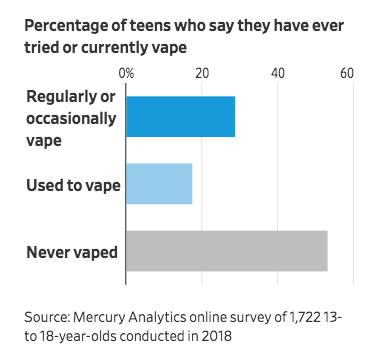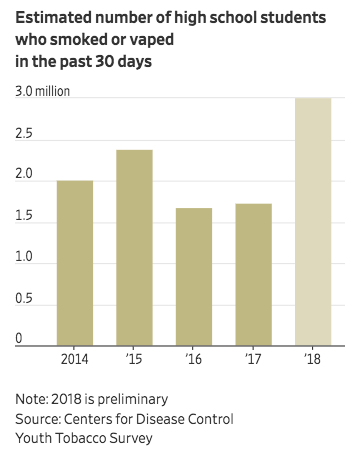Source: www.wsj.com
Authors: Betsy McKay and Jennifer Maloney
Number of high schoolers who used e-cigarettes in the past 30 days has risen some 75% in 2018
Teen use of e-cigarettes has soared this year, according to new research conducted in 2018 that suggest fast-changing youth habits will pose a challenge for public-health officials, schools and parents.
The number of high-school students who used e-cigarettes in the past 30 days has risen roughly 75% since last year, according to a person who has seen new preliminary federal data.
That would equate to about three million, or about 20% of high-school students, up from 1.73 million, or 11.7% of high-school students in the most recently published federal numbers from 2017.
Nearly a third of 13-to-18-year-olds who responded to a separate survey conducted by The Wall Street Journal with research firm Mercury Analytics said they currently vape.
The new numbers offer a rare look at evolving teen vaping habits. Sales of e-cigarettes are expected nearly to double this year over 2017, and researchers have wondered how much of that increase is because of teen use. But there can be a long lag time between the collection of data and public reports.
Most of the teens who vape said they are doing it for reasons other than to quit smoking, according to the Journal’s survey conducted in 49 states in May. More than half said they do it because they like the flavors that e-cigarette liquids come in and they think vaping is fun. More than two-thirds said they believe vaping can be part of a “healthy life.”
U.S. Food and Drug Commissioner Scott Gottlieb said last week that teen use “has reached an epidemic proportion.” He announced new measures to curb teen vaping and warned he is considering banning flavored products.
The preliminary federal numbers from 2018 are from the government’s latest National Youth Tobacco Survey, according to the person familiar with the data. The survey was conducted in the spring.
The number of high-school users of combustible, or traditional, cigarettes increased slightly from the 2017 survey, this person said.
Monitoring the Future, a long-running youth survey conducted by the University of Michigan, found in 2017 that 16.6% of 12th-graders and 13.1% of 10th-graders had vaped nicotine, marijuana or flavoring in the previous 30 days. Richard Miech, the survey’s principal investigator, said he believes there has been a “considerable jump” in adolescent vaping this year.
This year’s sales growth has been driven largely by the Juul, a slim device that resembles a flash drive and has become a status symbol among teens, who often vape sweet-flavored liquids like mango. Juul has a 72.8% dollar share of the estimated $2.5 billion market in channels measured by market-research firm Nielsen, according to a Wells Fargo analysis.
Health officials are concerned that the high levels of nicotine in some liquids can alter the chemistry of developing brains, making them more sensitive to addiction.
Juul Labs Inc. says its device is intended to help adult smokers quit. “We cannot be more emphatic on this point: No minor or non-nicotine user should ever try JUUL,” a spokeswoman said. “Our packaging includes a prominent nicotine label and clearly states for adult smokers.”
Parents and educators say they are trying to do more to combat vaping with children back to school. “There is a lot more that needs to be done because at this point there are so many thousands of kids who are addicted to nicotine,” said Meredith Berkman, a founder of Parents Against Vaping E-Cigarettes, which advocates for action to restrict e-cigarette access.
Trinity School in New York City, for example, plans this year to incorporate more material on e-cigarettes into its health-education program for students, said John Allman, head of school. “Parents are letting us know about this,” he said of teen use.
The Journal survey was conducted online with 1,722 participants initially, and most of the survey questions focused on 1,007 participants who said they either vape, used to vape, or know someone who vapes. Nearly three-quarters of the 1,007 participants were 17 or 18 years old; 62% were white, 21% were African-American and 18% were Hispanic. Rates of e-cigarette use are higher in older than younger teens.
A total of 501 participants said they vape: 153 regularly, and 348 occasionally. Their most common reasons for vaping were for the flavors, and because they think it’s cool. “I just enjoy the flavor and blowing really big clouds,” one participant wrote.
“It made me feel good the first time I tried it, and I got hooked,” wrote another.
When asked what they were inhaling, 71% said flavors, and 61% said nicotine.
More than two-thirds of the current vapers said they believe vaping can be part of a healthy life, though they believe there are some risks. More than half said their views of vaping had been influenced by posts on social media, an issue that has public-health experts concerned.
The percentage of respondents who said they vape is unusually high, and should be interpreted with caution, said David Abrams, a professor in the College of Global Public Health at New York University. “We can’t make too much of it,” he said, because the survey was conducted online, and the questions weren’t all asked the way they are asked on large academic or government surveys.
Measures taken by the FDA, Juul, schools and parents to limit underage access to vaping devices since this spring may also be having an effect, some experts say. “It’s possible that prevalence and use may decline over time,” said Jidong Huang, an associate professor of health management and policy at Georgia State University who studies e-cigarette use.



Leave A Comment
You must be logged in to post a comment.